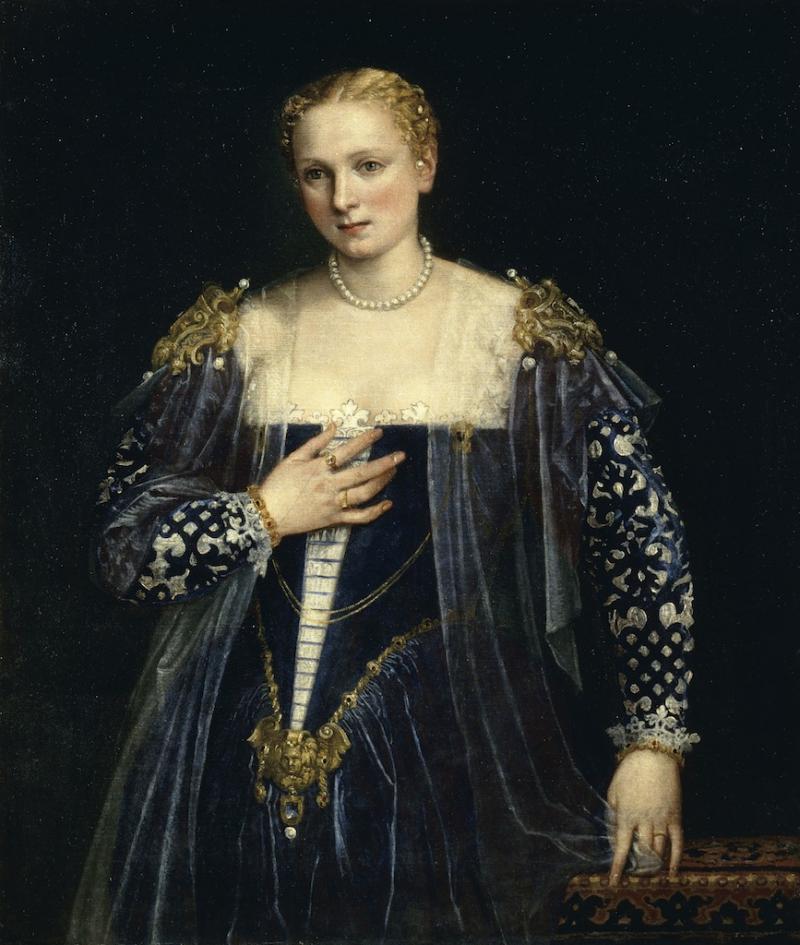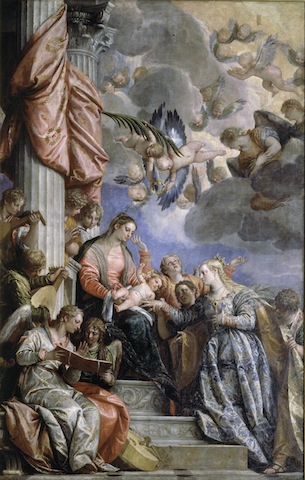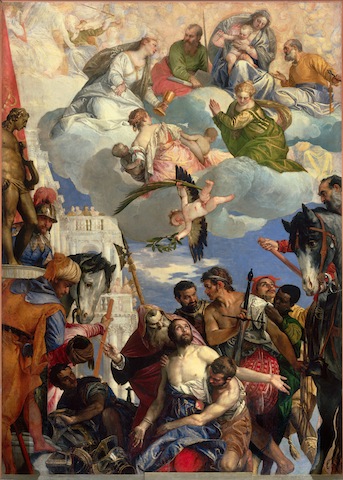Veronese: Magnificence in Renaissance Venice, National Gallery | reviews, news & interviews
Veronese: Magnificence in Renaissance Venice, National Gallery
Veronese: Magnificence in Renaissance Venice, National Gallery
A survey of the Venetian master whose paintings pulsate with a thrilling vitality

The National Gallery has produced a revelatory and unprecedented exhibition which shows us an array of paintings from cabinet size to mammoth by a long acknowledged star: Veronese, probably the most flamboyantly exciting artist at the heart of the Renaissance in Venice.
Paolo Caliari (1528-1588) known as Veronese in honour of his native city, was born in Verona the son of a stonecutter, and was originally destined to be a sculptor. Changing media, it is his 30-plus years or so in Venice at its artistic heights at the heart of the 16th century, that made him a force to be reckoned with, and an influence over subsequent centuries. In 1909 Henry James, who was in fact a serious art critic, called him the happiest of painters, nobly joyous, seeing life as a breezy festival (so unlike James himself).
He is emblematic of Veronese’s extraordinary vitality, a barely contained energy even when at his most thoughtful
What is art historically important about the current anthology, is that the 50 or so paintings on view, several temporarily absent from the very churches they were painted for, is that all are thought to be, by the latest scholarship, authentically and completely from the hand of Veronese himself.
Like other successful artists of his peer group he managed a successful studio, so of the 800 or so paintings in which he had a hand, many also had the contributions of those painters under his management. But these, as scholars say, are autograph, so we are able to see with unusual clarity the original, even idiosyncratic, ability of the master. And they are being seen in the best light possible in beautifully lit galleries against gunmetal walls the better to see the shimmering evanescent colour of which he was a master.
The paintings, large and small, deploy an enormous and daring colour spectrum: brilliantly contrasting, pitching red against red, oranges, pinks and yellows, greens and iridescent blues, and showing us every crease and shadow of the heavy brocades, patterned cloth, and rich folds of sumptuous fabrics.
Portraits of rich Venetian patricians wrap the dignified gentlemen in gorgeous robes enlivened with lynx fur. In his characteristic crowd scenes the exuberant colour schemes which tease the eye and persuade us to look both at the whole and its riveting details are outmatched by the peerless choreography of varied personages, old, young and in-between, swooping, stooping, kneeling, bending, and even just standing.
Here be saints and soldiers, goddesses and angels, cherubim and pagan noblemen. He gives us choreographed theatre, the teeming crowds of people convincingly portrayed across the width of the canvas. And each actor, in whatever drama, gestures to make sure we understand the import of the whole.
 Veronese is producer and director, and of course set designer: a showman of unparalleled imagination, making us believe in angels and saints posed in the blue sky, in celestial cities, in architectural settings of fluted columns, marble terraces, bridges, staircases, all the better to deploy both the human and divine comedy. The Mystic Marriage of Saint Catherine (pictured right) from the late 1560s does just that. Here we see angels chattering, the Virgin with the Christ Child serenely gazing out at the adoring crowd, while a musician plays. The substantial figure of St Catherine enrobed in gorgeous blue patterned brocade receives the miraculous ring; a hovering pair of winged fat babies holds a neat golden crown as though about to crown the Virgin herself.
Veronese is producer and director, and of course set designer: a showman of unparalleled imagination, making us believe in angels and saints posed in the blue sky, in celestial cities, in architectural settings of fluted columns, marble terraces, bridges, staircases, all the better to deploy both the human and divine comedy. The Mystic Marriage of Saint Catherine (pictured right) from the late 1560s does just that. Here we see angels chattering, the Virgin with the Christ Child serenely gazing out at the adoring crowd, while a musician plays. The substantial figure of St Catherine enrobed in gorgeous blue patterned brocade receives the miraculous ring; a hovering pair of winged fat babies holds a neat golden crown as though about to crown the Virgin herself.
The men of whatever age have faces that range from the breathtakingly handsome to the homely. But the bodies, when revealed, are idealised with amazing musculature, the envy of any 21st-century addict of physical fitness. Robes also allow for the visibility of bare feet at which Veronese is an expert too. Saints have dramatic faces with glistening upturned rolling eyes. The women are far more problematic and less convincing, less animated, robust and square-shaped, standing stiff in their costumes, usually almost expressionless. The naked goddesses, usually blonde, rosy cheeked and rosy nippled, are adoring, supple and very fleshy, even boneless.
 This unprecedented exhibition gives us a chance to see close up several altarpieces which, due to changes of ecclesiastical policy, can be temporarily removed from their original settings. The Martyrdom of Saint George (pictured left) from San Giorgio,Verona, really does seem to have almost every pose Veronese could think of: the pale kneeling figure of the saint, two horses, a motley colourful crowd of soldiers, servants, on-lookers, people in the distance piled onto balconies the better to observe the hubbub, a very mixed crowd of saints, babies, holy mothers, including Peter and Paul, not to mention Faith Hope and Charity, posed on billowing clouds above, who seem to be chatting away as they gesture to each other, and the carry-on below. Terrific accents of red ensure the eye is coaxed to travel round every ramification of the composition.
This unprecedented exhibition gives us a chance to see close up several altarpieces which, due to changes of ecclesiastical policy, can be temporarily removed from their original settings. The Martyrdom of Saint George (pictured left) from San Giorgio,Verona, really does seem to have almost every pose Veronese could think of: the pale kneeling figure of the saint, two horses, a motley colourful crowd of soldiers, servants, on-lookers, people in the distance piled onto balconies the better to observe the hubbub, a very mixed crowd of saints, babies, holy mothers, including Peter and Paul, not to mention Faith Hope and Charity, posed on billowing clouds above, who seem to be chatting away as they gesture to each other, and the carry-on below. Terrific accents of red ensure the eye is coaxed to travel round every ramification of the composition.
Seen together for the first time since presumably they inhabited the artist’s studio, are two contemporaneous Adoration of the Kings, both from about 1573, one from Santa Corona in Vicenza, the other National Gallery’s own, originally painted for a Venetian church and sold in the 19th century. Each is replete with miraculous shafts of light, with resplendently robed kings, a very gracious, demure Virgin, insouciant Baby, and requisite dogs, horses, oxen, even camels. What is fascinating about the two together is to see how the same elements can be woven by a master visionary into scenes which are similar yet different even in mood; one more sombre even militaristic, the other gentler, a flurry of kneeling figures cascading towards the Virgin and her holy burden.
There are paintings of individuals too; Saint Menna, part of huge shutters for the organ of a Venetian church, is a Roman soldier shown in full armour, a red cloak tossed with bravura over his shoulder; it seems he is about to step out of the classical niche that contains his life-size figure. He is emblematic of Veronese’s extraordinary vitality, a barely contained energy even when at his most thoughtful. Profound emotion is absent, contemplation hardly ever contemplated. Even the martyrs hardly exhibit sorrow or apprehension. Opulent splendour is the keynote. Only the portraits of real people seem occasionally pensive, with thoughts turned inward.
An overwhelming physical energy seems almost to pulsate through the paint. This is perhaps what most animates Veronese, an unstoppable life force in painted form. Enjoy!
Explore topics
Share this article
The future of Arts Journalism
You can stop theartsdesk.com closing!
We urgently need financing to survive. Our fundraising drive has thus far raised £49,000 but we need to reach £100,000 or we will be forced to close. Please contribute here: https://gofund.me/c3f6033d
And if you can forward this information to anyone who might assist, we’d be grateful.

Subscribe to theartsdesk.com
Thank you for continuing to read our work on theartsdesk.com. For unlimited access to every article in its entirety, including our archive of more than 15,000 pieces, we're asking for £5 per month or £40 per year. We feel it's a very good deal, and hope you do too.
To take a subscription now simply click here.
And if you're looking for that extra gift for a friend or family member, why not treat them to a theartsdesk.com gift subscription?
more Visual arts
 'We are bowled over!' Thank you for your messages of love and support
Much-appreciated words of commendation from readers and the cultural community
'We are bowled over!' Thank you for your messages of love and support
Much-appreciated words of commendation from readers and the cultural community
 Lee Miller, Tate Britain review - an extraordinary career that remains an enigma
Fashion photographer, artist or war reporter; will the real Lee Miller please step forward?
Lee Miller, Tate Britain review - an extraordinary career that remains an enigma
Fashion photographer, artist or war reporter; will the real Lee Miller please step forward?
 Kerry James Marshall: The Histories, Royal Academy review - a triumphant celebration of blackness
Room after room of glorious paintings
Kerry James Marshall: The Histories, Royal Academy review - a triumphant celebration of blackness
Room after room of glorious paintings
 Folkestone Triennial 2025 - landscape, seascape, art lovers' escape
Locally rooted festival brings home many but not all global concerns
Folkestone Triennial 2025 - landscape, seascape, art lovers' escape
Locally rooted festival brings home many but not all global concerns
 Sir Brian Clarke (1953-2025) - a personal tribute
Remembering an artist with a gift for the transcendent
Sir Brian Clarke (1953-2025) - a personal tribute
Remembering an artist with a gift for the transcendent
 Emily Kam Kngwarray, Tate Modern review - glimpses of another world
Pictures that are an affirmation of belonging
Emily Kam Kngwarray, Tate Modern review - glimpses of another world
Pictures that are an affirmation of belonging
 Kiefer / Van Gogh, Royal Academy review - a pairing of opposites
Small scale intensity meets large scale melodrama
Kiefer / Van Gogh, Royal Academy review - a pairing of opposites
Small scale intensity meets large scale melodrama
 Jenny Saville: The Anatomy of Painting, National Portrait Gallery review - a protégé losing her way
A brilliant painter in search of a worthwhile subject
Jenny Saville: The Anatomy of Painting, National Portrait Gallery review - a protégé losing her way
A brilliant painter in search of a worthwhile subject
 Abstract Erotic, Courtauld Gallery review - sculpture that is sensuous, funny and subversive
Testing the boundaries of good taste, and winning
Abstract Erotic, Courtauld Gallery review - sculpture that is sensuous, funny and subversive
Testing the boundaries of good taste, and winning
 Edward Burra, Tate Britain review - watercolour made mainstream
Social satire with a nasty bite
Edward Burra, Tate Britain review - watercolour made mainstream
Social satire with a nasty bite
 Ithell Colquhoun, Tate Britain review - revelations of a weird and wonderful world
Emanations from the unconscious
Ithell Colquhoun, Tate Britain review - revelations of a weird and wonderful world
Emanations from the unconscious
 Rachel Jones: Gated Canyons, Dulwich Picture Gallery review - teeth with a real bite
Mouths have never looked so good
Rachel Jones: Gated Canyons, Dulwich Picture Gallery review - teeth with a real bite
Mouths have never looked so good

Add comment